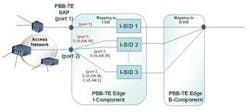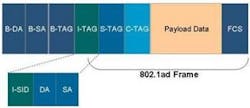This companion article to "Multipoint PBB-TE and T-MPLS" provides an overview of Provider Backbone Bridging and introduces Provider Link State Bridging, a link-state protocol alternative to Spanning Tree Protocol.
By DANIEL JOSEPH BARRY
TPACK
Provider Backbone Bridging (PBB) operates in exactly the same manner as IEEE 802.1ad (Q-in-Q). However, instead of operating on Customer and Service MAC addresses, a new Backbone MAC (B-MAC) address is used. The B-MAC is added at the edge of the PBB network, which is expected to be administered by a carrier or carriers' carrier.
PBB uses Multiple Spanning Tree Protocol (MSTP) to establish rooted broadcast domains in the network, with each domain associated with a Backbone Virtual LAN (B-VLAN). Unknown MAC addresses are only broadcast within the given B-VLAN.
With the I-SID, PBB also improves the scalability of Ethernet, which previously was restricted to 4,094 service instances due to the limited 12-bit VLAN field. The 24-bit I-SID now supports up to 16 million service instances. This effectively separates services from transport with services identified by the I-SID and the "transport" indicated by the B-VLAN broadcast domain.
Figure 1 depicts two key PBB components, the I-Component and the B-Component. The I-Component is responsible for mapping customer Ethernet traffic to the appropriate I-SID. The mapping can be per port, per port+S-VLAN, or per port+S-VLAN+C-VLAN. The B-Component is then responsible for mapping the I-SIDs to the appropriate B-VLANs.
Thus, PBB is a connectionless network based on Ethernet but with additions to improve scalability and separation of customer and backbone traffic. However, it lacks determinism in that it cannot be predicted which path traffic will take through the network. Each node learns where to forward packets, but should a change occur in the network, the paths to each destination B-MAC address need to be relearned by all nodes, leading to new traffic paths.
The PBB frame format (Figure 2) does provide one advantage in this regard: self-defining packets. Looking at the header of a PBB packet extracted at any point in the network will tell you where the packet came from, where it is going, which service it belongs to and which customer is being serviced. This is very useful information for troubleshooting and difficult to emulate in MPLS networks, since MPLS labels are switched at each node.
The combination of PBB and PBB-TE thus provides both point-to-point and multipoint connectivity. PBB and PBB-TE can be run on the same network from the same Carrier Ethernet switch, at the same time. In this regard, the combination of PBB and PBB-TE is similar to the combination of MPLS label switched paths (LSPs) and virtual private LAN service (VPLS) that is implemented in routers.
Introducing PLSB
One of the criticisms of PBB that was addressed in PBB-TE was the use of Spanning Tree Protocol (STP) as a control plane. Since STP endeavors to remove loops by closing ports and links, the use of STP results in wasted resources. It is also slow to recover from changes that take place in the network and to recalculate the optimal paths in the network (a process referred to as "convergence").
PBB-TE removed STP entirely, favoring a network management approach for population of forwarding tables in each node. Broadcasting and flooding of unknown MAC addresses was removed, which was also advantageous.
To solve the issue of STP in PBB, a link-state protocol based on Intermediate System to Intermediate System (IS-IS) protocol is proposed, in which the IP address identifiers in IS-IS have been replaced by Ethernet MACs. Provider Link State Bridging (PLSB) is the result.
The use of link-state protocols in Layer 2 applications is not new. ATM used a private network to network interface (PNNI) protocol that used a path computation mechanism similar to IS-IS. Open Shortest Path First (OSPF) in MPLS is also an example of a link-state protocol.
IS-IS is used to calculate the best path through the network and to disseminate this information to all nodes, in much the same manner as OSPF is used to calculate paths for LSPs in VPLS.
In PLSB, IS-IS is used to configure a rooted point-to-multipoint tree for each Backbone Edge Bridge (BEB) node, which provides connectivity to all other BEBs via intermediate Backbone Core Bridges (BCBs). A congruent multipoint-to-point tree is also established from each BEB back to the originating BEB. Thus, traffic always follows the same path to and from each BEB.
Using IS-IS and configuration rather than learning means that flooding and broadcasting of unknown MAC addresses in the core of the network is no longer necessary and no ports or links need to be closed. IS-IS also converges much faster than STP, which means that fault situations with recomputation of paths are resolved in hundreds of milliseconds rather than seconds.
Since traffic follows the same path to and from each BEB, the network is more deterministic and OAM mechanisms can be used. It also enables a solution to looping based on Reverse Path Forwarding Check (RPFC). In RPFC, the fact that the path to a destination is the same as the path from a destination means that a received packet can be checked against this path to make sure that it has been received on the right interface. If it hasn't, then a loop must have occurred and the packet is dropped.
PLSB and PBB offer an alternative approach to VPLS to realize multipoint connections. The combination avoids the need for full mesh connectivity as the two protocols create, in principle, a connectionless network. However, by using configuration rather than learning, PLSB ensures that the path to each destination is symmetric (or congruent) and deterministic, to a certain extent. Faults and other major changes along the path will have to result in a new path being configured.
Another advantage of PLSB is that a single control protocol is used. This reduces the complexity of the approach compared to MPLS.
It should be noted that there are natural limits to the number of nodes that can be supported using link-state protocols. For example, OSPF typically supports up to 200 nodes before it starts to suffer. This was one of the driving motivations for introducing BGP. According to Nortel, IS-IS can support up to 400 backbone nodes or more within a given domain.
PLSB is relatively new and currently being promoted by Nortel. It looks promising, but time will tell whether this approach proves popular and can win more adherents and carrier support.
Daniel Joseph Barry is director of marketing at TPACK (www.tpack.com).

